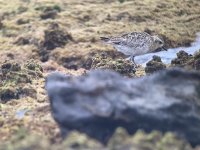MKinHK
Mike Kilburn

I'd be interested in any thoughts on this golden plover sp. I photographed at Long Reef in Sydney this evening.

There is a short Youtube clip here:
It appears to show four primary tips extending beyond the longest tertial, which I believe is a diagnostic feature of American Golden Plover, which is a major rarity here. However this may not be the longest tertial as the bird appears to have moulted one or more other tertials. the bird also appeared less yellow-tinged than the other Pacific Golden plovers present, which also appeared to show the typical short projection beyond the tertials of Pacific Golden Plover.
The visible long tertial also appears to mostly un-notched, which appears also to suggest American.
Many thanks for any thoughts
Cheers
Mike

There is a short Youtube clip here:
It appears to show four primary tips extending beyond the longest tertial, which I believe is a diagnostic feature of American Golden Plover, which is a major rarity here. However this may not be the longest tertial as the bird appears to have moulted one or more other tertials. the bird also appeared less yellow-tinged than the other Pacific Golden plovers present, which also appeared to show the typical short projection beyond the tertials of Pacific Golden Plover.
The visible long tertial also appears to mostly un-notched, which appears also to suggest American.
Many thanks for any thoughts
Cheers
Mike
Last edited:



